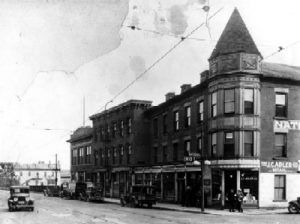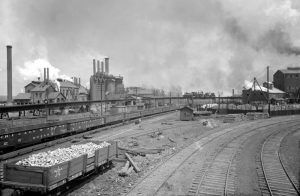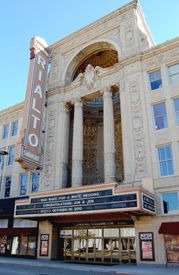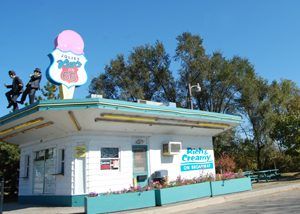Joliet, Illinois, the county seat of Will County, is a major suburb of Chicago and is now called home to about 150,000 people.
Joliet originally bore the name “Juliet,” which was probably a corruption of French Canadian explorer Louis Jolliet’s name. Jolliet first explored this area in the fall of 1673, describing the game as abundant and the prairies wide, surrounded by lush forests.
Though a settlement already existed, the official town wasn’t laid out until 1834. Attracted to the Des Plaines River and the area’s fertile soil, early settlers found ample reason to stay, and the town began to grow.
Work on the famous National Hotel began in 1837, which soon became an important social center for the town, hosting many balls and social gatherings for the burgeoning city. By 1838, Joliet boasted a courthouse with a jail in the basement sunk into solid rock. At times the courthouse also served as a church. A new and better courthouse was built in 1848. The opening of the Illinois & Michigan Canal in the same year welcomed Joliet into an era of aggressive growth in industrial and residential development. Unfortunately, the National Hotel building burned down in 1958.
Soon, mills and factories sprang up, and the discovery of rich limestone deposits created a new quarrying industry that flourished. Joliet, like its counterpart, Romeoville down the road, was also called “Stone City.”
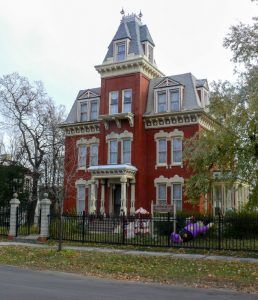
Jacob Henry Mansion, Joliet, Illinois by David Wilson, Flickr.
In 1873, the Joliet Opera House was built on the northwest corner of Chicago and Clinton Streets for $60,000. Opening on February 2, 1874, the establishment hosted a variety of functions, from burlesque shows to religious revivals. In the summer of 1890, plans were unveiled for a $15,000 expansion project; however, the Opera House was destroyed by fire on March 1891. Wasting no time, the Opera House was rebuilt in the same location the following year and continued to serve the community for many years.
In 1876 a railroad tycoon named Jacob A. Henry built a 16,800 square foot mansion from limestone from his quarry. The 40-room home was lavishly finished with walnut and oak fixtures on the inside, including a solid walnut staircase with 119 hand-carved octagonal spindles. The home, which is a museum today, is said to be the largest and best example of Renaissance Revival architecture still in existence in Illinois.
In the late 1800s, the abundance of soft coal in the area made Joliet a perfect location for the emerging steel industry, and soon Joliet was established as a steel town, the success of which brought with it a flood of new residents. The Joliet Steel Works eventually became unprofitable, and all operations were ceased by the early 1980s. Today the ruins of the old iron and steelworks are preserved as a state historic site. A 1.5-mile trail near the old Illinois and Michigan Canal provides visitors interpretive signs views of the remains of the Joliet Iron Works.
Joliet’s Union Station, built in 1912, once catered to the glamorous rail travelers of the early 1900s. Complete with a Grand Ballroom, crystal chandeliers, and 45-foot ceilings, the union station is now listed on the National Register of Historic Places.
On May 24, 1926, the Rialto Theater opened, unveiling a stunning reflection of Greek, Roman, and Byzantine architecture. Theatre-goers that night paid 50 cents to see the silent movie “Mademoiselle Modiste.” Serving the public for years, the theater underwent a complete restoration in 1980 and continues to offer a wide selection of performances today.
The Louis Joliet Hotel, built in 1927, was the finest in Joliet, known for its legendary elegance and luxury. The eight-story hotel featured 225 rooms above a two-story central lobby and lounge, complete with a large fireplace and a hand-carved Bedford stone mantel. The hotel operated until 1964, and the building was designated a national landmark in 1989. It has recently been converted into 56 apartments linked to the revitalization of Joliet’s City Center.
On December 26, 1956, Peter and Helen Cinquegrani opened the first McDonald’s Restaurant in the Joliet area on west Jefferson Street. Enjoying tremendous success, the flickering red and white neon arches drew many a Route 66 traveler in for a 15 cent hamburger or French Fries for just ten cents.
Once an industrial city, Joliet and its population of just over 100,000 has reinvented itself today as a tourist destination providing numerous historic sites and entertainment activities. While traveling through Joliet, be sure to look for the many larger-than-life murals located all over town, visit the Rialto Theater, and cross the Ruby Street Bridge on old Route 66.
The Joliet Historical Museum at 204 N. Ottawa Street includes a Route 66 Welcome Center.
For those following Route 66, the old highway follows Illinois Highway 53 to Wilmington, about continues for 16 miles to the south.
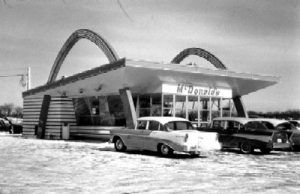
This vintage McDonald’s opened in 1956 in Joliet, photo courtesy Joliet History.
© Kathy Weiser-Alexander/Legends of America, updated November 2021.
Also See:


